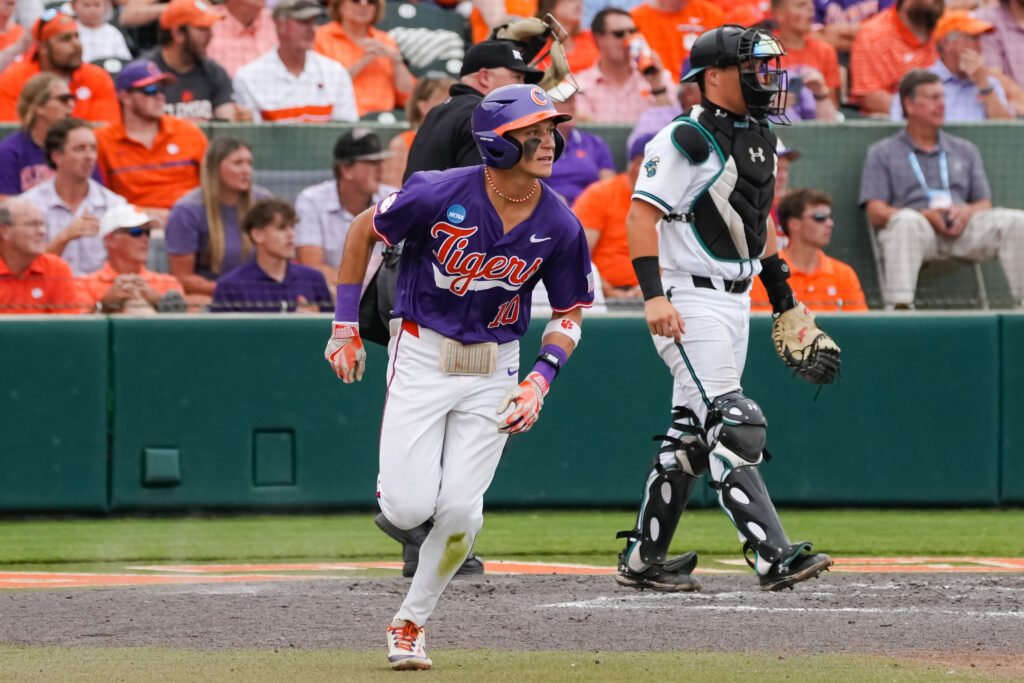Tigers, Mountaineers, Wildcats, and Spartans Set for Clash at Doug Kingsmore
There’s a certain buzz around Doug Kingsmore Stadium that feels different this year. Maybe it’s the memory of last year’s heartbreaking exit in the Super Regionals still lingering against Florida. Maybe it’s the electric energy that Clemson head coach Erik Bakich has instilled in this Clemson program. Or maybe it’s the fact that, for the third straight season, the Tigers are hosting a regional, something them and Arkansas has only done.
Clemson enters the 2025 NCAA Tournament as the No. 11 national seed, drawing a challenging regional featuring the Big 12 regular season champion West Virginia Mountaineers, a battle-tested Kentucky squad from the loaded SEC, and an upstart USC Upstate team that holds one of the nation’s most dangerous offenses. There are regionals built on star power, and there are regionals built on chaos. This one might just offer both.
The Tigers’ Third Time Charm?
The Clemson Tigers come into the regional at 44-16 overall and 21-13 in the ACC, riding the momentum of a solid postseason showing in Durham and a team that looks hungry to take the next step. In 2023, Clemson stumbled in its home regional. In 2024, they pushed Florida to the brink in a classic Super Regional series. This year, they believe they’re ready to break through.
Central to that belief is Cam Cannarella, the heart and soul of this Clemson team. The junior center fielder isn’t just the Tigers’ best defensive player, he might be the best in the country. A human highlight reel in the outfield, Cannarella’s glove saved Clemson on multiple occasions this year, just as it did last June with his iconic over-the-shoulder catch against Florida.
But Cannarella isn’t just flash with the leather. He’s heated up offensively down the stretch, slashing .344/.477/.495 with more walks than strikeouts and leading the team in both doubles (20) and heart-pounding moments. When Bakich says Cannarella shines brightest in high-leverage situations, it’s not Coach Bakich just saying that, it’s lived experience.

While Cam Cannarella might grab the spotlight, it’s been Clemson’s bullpen that has really cemented this team’s identity as of late. The Tigers feature one of the best relief corps in the tournament. Closer Lucas Mahlstedt is the rock for the Tigers with 15 saves, 59 strikeouts, and just 7 walks in 45 innings, but he’s far from alone. Getting Reed Garris back from injury gives Clemson another dominant option (1.33 ERA in 27 IP), while Joe Allen and Jacob McGovern have settled into crucial middle innings roles. In a regional where late-game swings could be everything, Clemson’s bullpen is its anchor.
On the mound to start the weekend, sophomore Aidan Knaak is the tone-setter for the Tigers. Armed with a lethal changeup and postseason experience, Knaak has been at his best lately, giving the Tigers 13.1 innings of two-run ball in his last two outings. If he can stay sharp, Clemson has a very real path to Sunday night without dropping into the loser’s bracket.
West Virginia’s Two-Sided Tale
West Virginia might be the most up and down team in the regional. At their best, the Mountaineers looked like a national seed as they won the Big 12 regular season title and sat at 39-7 entering May. But a 2-7 stretch to close the season much of it due to bullpen woes that has cooled their momentum.
Still, they have the arms to make a run, starting with frontline starters Griffin Kirn and Jack Karstonas. The issue has been depth, a weakness that’s become a problem for them in recent weeks. Carson Estridge, once a lights-out reliever, has struggled badly in his last four outings. If WVU wants to keep pace, he and the rest of the bullpen need to turn the corner quickly.
Offensively, the Mountaineers aren’t explosive, but they’re efficient as they rank in the top 100 nationally in average, OBP, and slugging. The lineup doesn’t overwhelm with power (just 54 home runs), but they’ve been battle-tested in a rugged Big 12 conference and can grind out wins. If they get even average relief pitching, they’re a dangerous team to watch out for.
Kentucky’s Omaha Blueprint
Then there’s Kentucky, a team that doesn’t enter with the flashiest record sitting at 29-24 and just 13-18 in the SEC, but still very much a threat. The Wildcats earned their stripes by surviving a brutal conference slate and have the most consistent starting rotation in the regional. Nate Harris, Nic McCay, and Ben Cleaver have formed a dependable trio, with Cleaver’s 87 strikeouts in 77 innings leading the way.
This isn’t a team that bashes its way to wins with their offense ranking just 145th in runs per game and 181st in slugging. But what they lack in fireworks, they make up for in experience and efficiency. Kentucky won’t beat themselves, and in a regional like this one, that counts for a lot.
Last year, the Wildcats made it to Omaha. If the pitching holds and they can get just enough from the bats, they could have another run in them.
The Spartan Surge
And then there’s USC Upstate, the frisky four-seed nobody wants to face.
Back on March 4th, the Tigers and Spartans squared off at Fluor Field in Greenville, where USC Upstate gave Clemson an early challenge, holding the Tigers scoreless through the first four innings. Although Clemson eventually pulled away for a 7-0 victory, the game was a reminder of how gritty and competitive this Upstate team can be. Having already faced the Tigers once this season, the Spartans will be looking to play spoiler in Friday’s series opener. While that matchup was months ago and plenty has changed since then, it’s still a performance worth remembering heading into this weekend.
Under first-year head coach Kane Sweeney, the Spartans finally broke through after years of knocking on the door. They won 22 of 27 in Big South play, swept through their conference tournament, and come in with one of the most terrifying lineups in the country.
They average 9.7 runs per game, second nationally. They’ve hit 99 home runs. And they don’t just feast at home, their .898 OPS on the road is proof that this offense travels. The spark comes from a trio of stars: leadoff man Henry Zenor (.367/.457/.566), dynamic slugger Vance Sheahan (.331/.401/.527 with 25 stolen bases), and their offensive anchor, Johnny Sweeney.
Sweeney, the coach’s younger brother, has gone from afterthought to force, slashing .351/.702/.504 with 17 homers and 81 RBIs. His bat has destroyed secondaries this year, especially changeups — an important note given that Aidan Knaak relies so heavily on his.
The question for the Spartans is whether the pitching can hold up. Their team ERA of 5.40 ranks worst in the regional. But if they get an early lead, they have enough firepower to slug their way to an upset. They’re the best 4-seed in the field, and it’s not particularly close.
What to Expect at DKS
This regional isn’t just loaded with talent, it’s also full of storylines. Can Clemson punch through and reach the Supers on their home field again? Can West Virginia rediscover the form that had them looking like a top-eight team? Will Kentucky ride its arms back to Omaha? And can USC Upstate become this year’s Cinderella?
Expect a rowdy environment. Doug Kingsmore Stadium has become one of the premier postseason venues under Erik Bakich, and the Clemson fan base feels the urgency as this year feels like unfinished business. The Tigers have the arms, the leadership, and the defense to make a run, but they’ll need to be very sharp. West Virginia and Kentucky are both capable of playing spoiler, and Upstate’s offense is too potent to sleep on.
One thing’s certain: the 2025 Clemson Regional has the potential to be one of the most exciting opening rounds in the tournament. Buckle up. This weekend at Doug Kingsmore Stadium might just deliver fireworks and be must watch baseball. This is what postseason baseball is all about.
2025 Clemson Baseball Regional Schedule
Location: Doug Kingsmore Stadium – Clemson, SC
Friday, May 30
Game 1: Kentucky vs. West Virginia – 12:00 p.m.
Game 2: USC Upstate vs. Clemson – 6:00 p.m.
Saturday, May 31
Game 3: Game 1 Loser vs. Game 2 Loser – 12:00 p.m.
Game 4: Game 1 Winner vs. Game 2 Winner – 6:00 p.m.
Sunday, June 1
Game 5: Game 3 Winner vs. Game 4 Loser – 12:00 p.m.
Game 6: Game 4 Winner vs. Game 5 Winner – 6:00 p.m.
Monday, June 2 (if necessary)
Game 7: If necessary – TBA





















